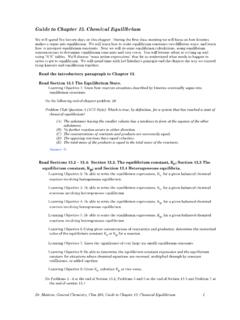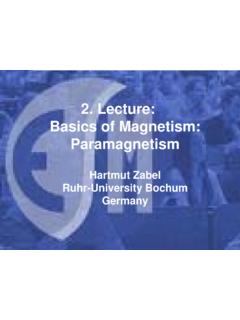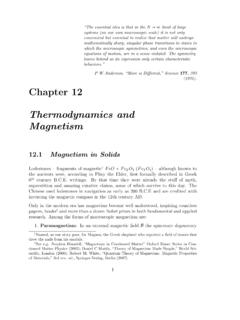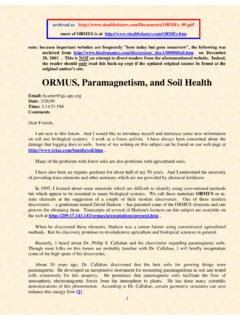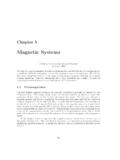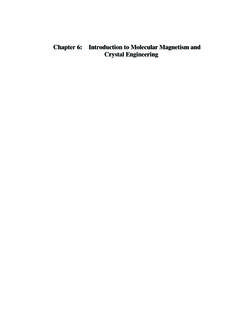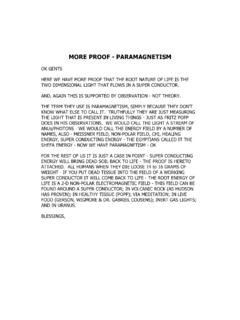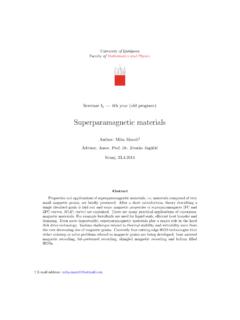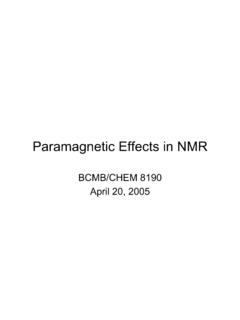Transcription of Microscale Demonstration of the Paramagnetism of Liquid ...
1 1 Microscale Demonstration of the Paramagnetism ofLiquid Oxygen with a Neodymium Mattson*, Creighton University, Omaha, Nebraska a neodymium magnet is brought near a suspended small glass tube ( mL) containing 2mmol (64 mg) Liquid oxygen, the tube is attracted to the magnet demonstrating oxygen s amounts of Liquid oxygen can be produced in a similar fashion using a sandwich bag filled withoxygen in place of a 60-mL syringe used to condense 2 mmol oxygen. On the larger scale, the blue colorof Liquid oxygen is readily observable by : First-Year Undergraduate / General, Upper-Division UndergraduateKeywords: Inorganic chemistry, Oxygen, Descriptive chemistry, Molecular properties and structure,Free radicals, Gases, Magnetic properties, MO Theory2 Microscale Demonstration of the Paramagnetism ofLiquid Oxygen with a Neodymium Mattson*, Creighton University, Omaha, Nebraska teachers have seen the impressive photograph of Liquid oxygen suspended between thepoles of a large magnet.
2 The photograph is commonly found in general chemistry Inconjunction with a discussion of how molecular orbital theory correctly predicts oxygen sparamagnetism, those of us who make use of classroom demonstrations are left with relatively fewoptions to show the class an actual example. In this Journal, one article has appeared that describes howsoap bubbles of oxygen gas are attracted to a powerful (1800 gauss) magnet (1). A similardemonstration, simple, yet poignant, can be viewed on the web (2). We describe here a truly microscaleclassroom Demonstration of the paramagnetic behavior of samples as small as 60 mg Liquid oxygen andthe apparatus shown in Figure 1. Paramagnetism of Liquid Oxygen device3A similar technique was reported earlier as a Tested Demonstration in which relative molar magneticsusceptibilities are tested using a neodymium magnet (3).
3 Apparatus shown in Figure 1 is constructed from a glass Pasteur pipet, a 20 cm length ofsewing thread, a 25 cm length of heavy ( 12 gauge) copper wire, 3 cm electricians tape, and a woodenbase (approximately 10 cm x 10 cm x 2 cm.) Use a Bunsen burner to seal the bottom of a glass pipet atthe point there the diameter changes between the tip and the body. This will create a small test tube witha capacity of approximately mL. Tape both ends of a 15 cm length of sewing thread at oppositesides of the pipet s open end to form a pail-like handle. The loop of thread will hang from the supporthook. The vessel must be suspended above the glass Pasteur pipeto 20 cm length of sewing threado 25 cm length of heavy ( 12 gauge) copper wireo 3 cm electricians tapeo wooden base (approximately 10 cm x 10 cm x 2 cm.)o 60 mL plastic syringe, with a LuerLok fittingo syringe cap fitting, Latex LuerLoko Latex tubing, 1/8-inch ( mm) ID, 2-cm lengtho pinch clamp such as a hemostato Neodymium magneto plastic beverage cup, clear PETE (9 oz, 250 mL)o Optional: freezer-quality quart (1 L) size food storage bag and a 10 cm length of Latextubing (1/8-inch ( mm) ID)Chemicals required for Demonstration supply of oxygen (CAS Number 7782-44-7) Liquid nitrogen (in a dewar flask) (CAS Number 7727-37-9)4 Optional projection is a small scale Demonstration .
4 Using it in a large classroom will require some sort ofprojection. We created a pipet vessel with a longer string (90 100 cm) that we hung from the lens headof an Elmo document camera. This projected well while providing a top view of the pipet. Motioncaused by the magnet was easily observed by the class. Using this approach, one does not need the wiresupport shown in Figure :Fill the syringe with oxygen as follows. Connect the syringe and the 3-cm length of tubing. Thetubing fits snugly over the inner part of the LuerLok fitting. If oxygen is being used from a compressedgas cylinder, run some oxygen out in order to purge the regulator of air. The regulator should have a fine-control-knob. Adjust the pressure to 100 kPa (1 atm, 15 psi) using the gas regulator knob. Connect thesyringe/tubing syringe (plunger fully inserted) to the regulator and slowly fill the syringe with : If too much gas is discharged, the plunger could become a flying projectile!
5 Hold the syringeso that the plunger will hit the floor if this happens. Once the syringe contains 60 mL oxygen,disconnect the syringe/tubing and seal the tubing shut with the pinch clamp. Oxygen can also begenerated inside the syringe from 6% hydrogen peroxide and solid potassium iodide (4 6).Remove the pipet/thread device from the apparatus and connect the pipet to the syringe ofoxygen using the Latex tubing (Figure 2). Note: The tubing makes a snug fit inside the opening of theopen end of the glass pipet; do not attempt to stretch it over the 2. Connecting pipet to syringe with tubing: tubing fits inside the the safety precautions regarding Liquid nitrogen and Liquid oxygen. Position theneodymium magnet close to the apparatus so it will be available when needed. The Demonstration isnow ready!Pour Liquid nitrogen into the plastic cup.
6 Hold the bottom third of the pipet in the liquidnitrogen. Within a few seconds the syringe plunger will move inward as the oxygen gas condenses in thepipet. After the oxygen has condensed and the syringe is empty, remove the tubing from the pipet andimmediately suspend the pipet from the wire hook of the apparatus. Quell any random movement thatthe pipet may be making by touching a finger to the pipet above the cold region. The Liquid oxygen isinitially about 5 mm deep inside the pipet but vaporizes rapidly. Some Liquid should remain present forat least 30 s, so the Demonstration must be completed quickly. Hold the neodymium magnet near theside and bottom of the pipet. Once the magnet is within a few mm of the pipet, it will swing towardsthe magnet and possibly hit it with a small, but audible 3. Conducting the experiment: Liquid oxygen is attracted to the neodymium bag Demonstration can be scaled up in terms of the quantity of oxygen used, but using the sameapparatus.
7 Instead of a 60-mL syringe, a 1-L freezer-quality plastic, sealable, food storage bag is for construction of this gas bag (5 7) can be summarized as follows. Seal a new foodstorage bag with some air inside. Press in the bag to insure that the bag is airtight. With a pencil, poke ahole through the bag. The hole should be slightly smaller in diameter than the tubing. Moisten thetubing and work it through the hole in the bag. The gas bag in now ready for use. Follow the sameinstructions as given above for filling the bag (do not overfill) and conducting the experiment. There areseveral advantages with this option. Some individuals may find gas bags easier to use than the syringemethod. Considerably more Liquid oxygen will be produced so the demonstrator can allow students tosee the blue color of the Liquid oxygen. The color is best observed while keeping the pipet immersed inthe Liquid nitrogen.
8 This prevents frost from forming and obscuring the view. Another advantage ofworking on this larger scale is that the demonstrator has more time to work with the magnet and theapparatus containing the Liquid oxygen. After the Demonstration , allow the Liquid oxygen to vaporize inthe pipet 4. The 1-L gas bag made from a freezer food storage bagSafety Concerns and wear safety glasses!7 Liquefied gases must never be stored in a closed system. Note: None of the equipment describedin this article would create such a gases cause cryoscopic burns. Avoid dermal oxygen can react violently with organic matter. Do not use oxygen near open flames orwhere sparks are generated. Interested readers can learn more about Liquid oxygen hazards from thisJournal (8).Supplemental MaterialA Quicktime movie of this Demonstration is available at JCE Online and ~ The movie was produced by Jiro Fujita ofCreighton Literature Cited:1.
9 Shimada, H.; Yasuoka, T.; Mitzuzawa; S., J. Chem. Educ. 1990, 67, (accessed on 26 April 2006)3. Malerich, Charles J.; Ruff, Patricia K. "Demonstrating and Measuring Relative Molar MagneticSusceptibility Using a Neodymium Magnet", J. Chem. Educ. 2004, 81, Mattson, B. M.; Lannan, J. Chem13 News, 1997, 254, 6 Mattson, B. M., Anderson, M. P., and Mattson, S. E., Microscale Gas Chemistry, EducationalInnovations, 2006, catalog #BK-595, ISBN # (successfully accessed 26 April 2006)7. Mattson, B. M. and Meyer, A., Microscale Gas Chemistry, Part 22. Ziploc Bags for TemporaryGas Storage and Transfer ; Chem13 News, 311, April, 2003, 13 Mitschele, J., J. Chem. Educ. 2003, 80, :1 The first four general chemistry texts I checked had such a photograph. Texts checked were: Chemistry,McMurrey Chemistry and Chemical Activity; Kotz and Treichel, Chemistry, Molecules,matter and Change; Jones and Atkins and Chemistry, Zumdahl and Syringes and related equipment can be ordered from a variety of vendors including EducationalInnovations, Flinn Scientific (US sales only), Micromole and Fisher Scientific.
10 Part numbers andlinks to their websites are provided at our Microscale gas website [5].9 Mattson, Microscale Demonstration of the Paramagnetism of Liquid Oxygen with a 1. Paramagnetism of Liquid Oxygen device10 Mattson, Microscale Demonstration of the Paramagnetism of Liquid Oxygen with a 2. Connecting pipet to syringe with tubing: tubing fits inside the , Microscale Demonstration of the Paramagnetism of Liquid Oxygen with a 3. Conducting the experiment: Liquid oxygen is attracted to the neodymium , Microscale Demonstration of the Paramagnetism of Liquid Oxygen with a 4. The 1-L gas bag made from a freezer food storage bag
